SOC103A Report: Australian Mandatory Detention Policy Analysis
VerifiedAdded on 2022/11/14
|10
|1931
|309
Report
AI Summary
This report delves into the realm of social policy development, using the Australian Mandatory Detention Policy as a central case study. It begins by defining social policy and its significance in addressing societal challenges, then explores various approaches to policy development, including the top-down method and the policy cycle. The report highlights the limitations of the top-down approach, advocating for a more dynamic, interactive policy cycle. The core of the report examines the Australian Mandatory Detention Policy, analyzing its process, implementation, and evaluation. It critically assesses the policy's impact on human rights and international laws, particularly concerning justice and fairness. The report concludes by identifying shortcomings within the policy and emphasizes the need for reevaluation to align with social welfare principles.
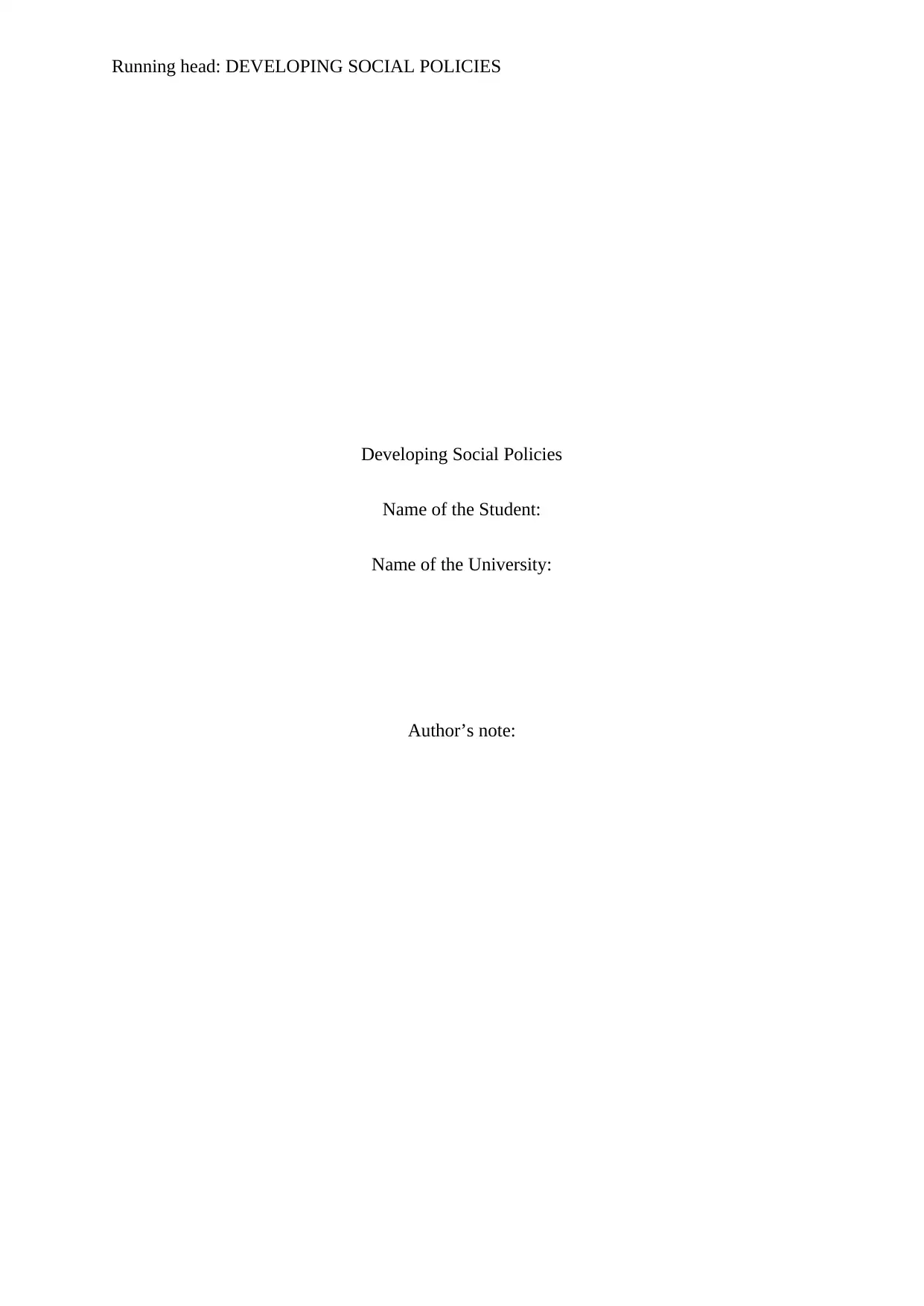
Running head: DEVELOPING SOCIAL POLICIES
Developing Social Policies
Name of the Student:
Name of the University:
Author’s note:
Developing Social Policies
Name of the Student:
Name of the University:
Author’s note:
Paraphrase This Document
Need a fresh take? Get an instant paraphrase of this document with our AI Paraphraser
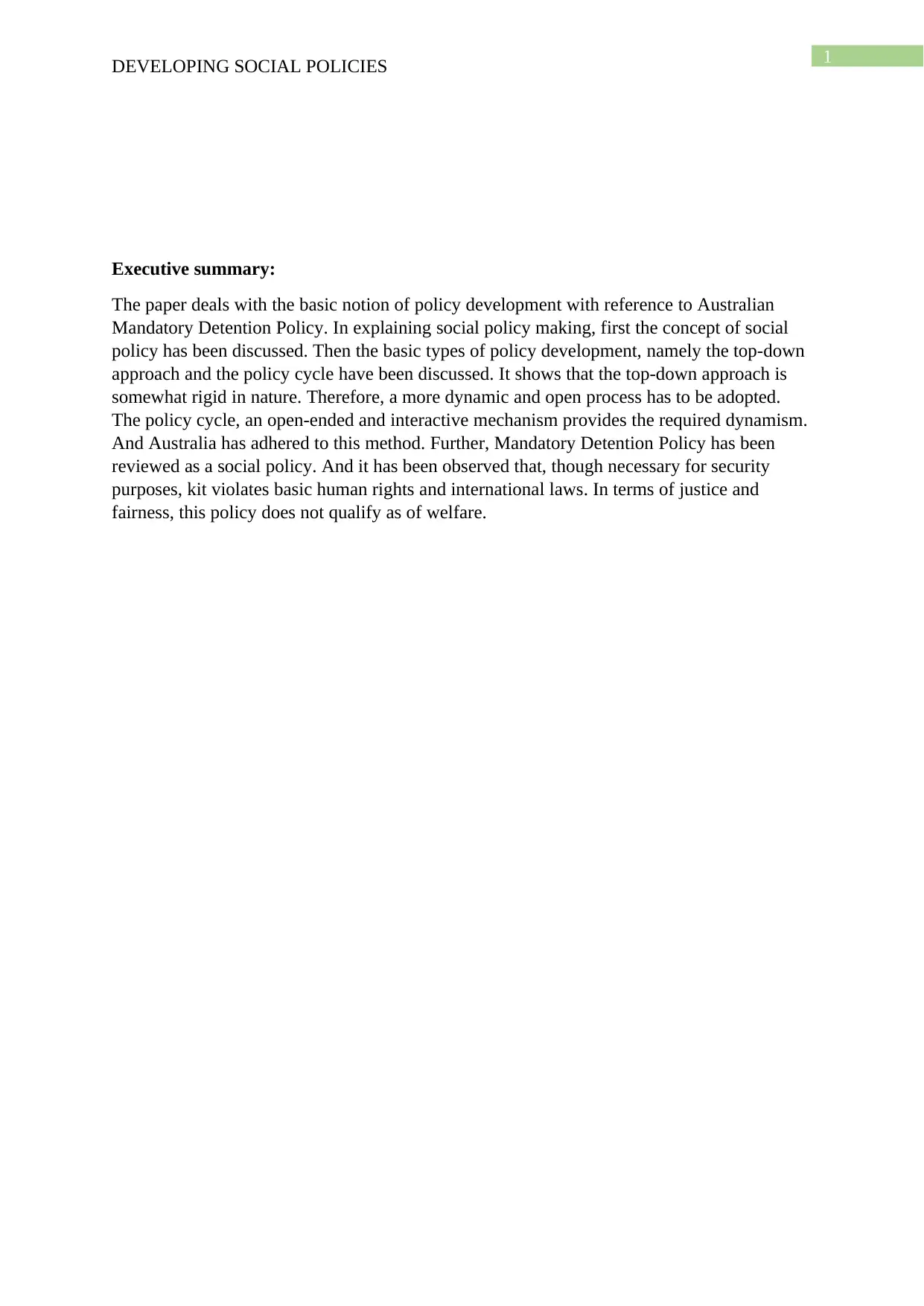
1
DEVELOPING SOCIAL POLICIES
Executive summary:
The paper deals with the basic notion of policy development with reference to Australian
Mandatory Detention Policy. In explaining social policy making, first the concept of social
policy has been discussed. Then the basic types of policy development, namely the top-down
approach and the policy cycle have been discussed. It shows that the top-down approach is
somewhat rigid in nature. Therefore, a more dynamic and open process has to be adopted.
The policy cycle, an open-ended and interactive mechanism provides the required dynamism.
And Australia has adhered to this method. Further, Mandatory Detention Policy has been
reviewed as a social policy. And it has been observed that, though necessary for security
purposes, kit violates basic human rights and international laws. In terms of justice and
fairness, this policy does not qualify as of welfare.
DEVELOPING SOCIAL POLICIES
Executive summary:
The paper deals with the basic notion of policy development with reference to Australian
Mandatory Detention Policy. In explaining social policy making, first the concept of social
policy has been discussed. Then the basic types of policy development, namely the top-down
approach and the policy cycle have been discussed. It shows that the top-down approach is
somewhat rigid in nature. Therefore, a more dynamic and open process has to be adopted.
The policy cycle, an open-ended and interactive mechanism provides the required dynamism.
And Australia has adhered to this method. Further, Mandatory Detention Policy has been
reviewed as a social policy. And it has been observed that, though necessary for security
purposes, kit violates basic human rights and international laws. In terms of justice and
fairness, this policy does not qualify as of welfare.
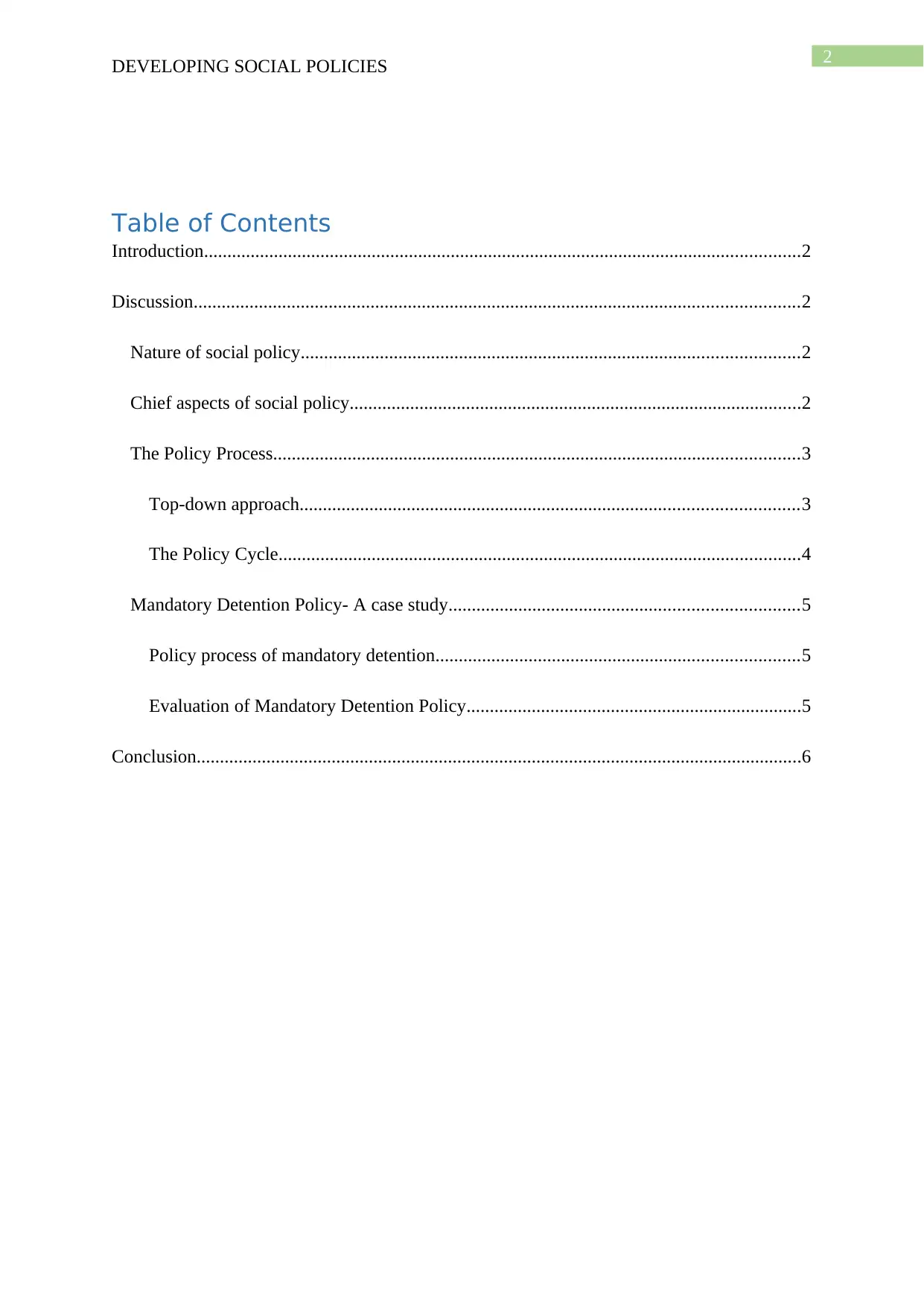
2
DEVELOPING SOCIAL POLICIES
Table of Contents
Introduction................................................................................................................................2
Discussion..................................................................................................................................2
Nature of social policy...........................................................................................................2
Chief aspects of social policy.................................................................................................2
The Policy Process.................................................................................................................3
Top-down approach...........................................................................................................3
The Policy Cycle................................................................................................................4
Mandatory Detention Policy- A case study...........................................................................5
Policy process of mandatory detention..............................................................................5
Evaluation of Mandatory Detention Policy........................................................................5
Conclusion..................................................................................................................................6
DEVELOPING SOCIAL POLICIES
Table of Contents
Introduction................................................................................................................................2
Discussion..................................................................................................................................2
Nature of social policy...........................................................................................................2
Chief aspects of social policy.................................................................................................2
The Policy Process.................................................................................................................3
Top-down approach...........................................................................................................3
The Policy Cycle................................................................................................................4
Mandatory Detention Policy- A case study...........................................................................5
Policy process of mandatory detention..............................................................................5
Evaluation of Mandatory Detention Policy........................................................................5
Conclusion..................................................................................................................................6
⊘ This is a preview!⊘
Do you want full access?
Subscribe today to unlock all pages.

Trusted by 1+ million students worldwide
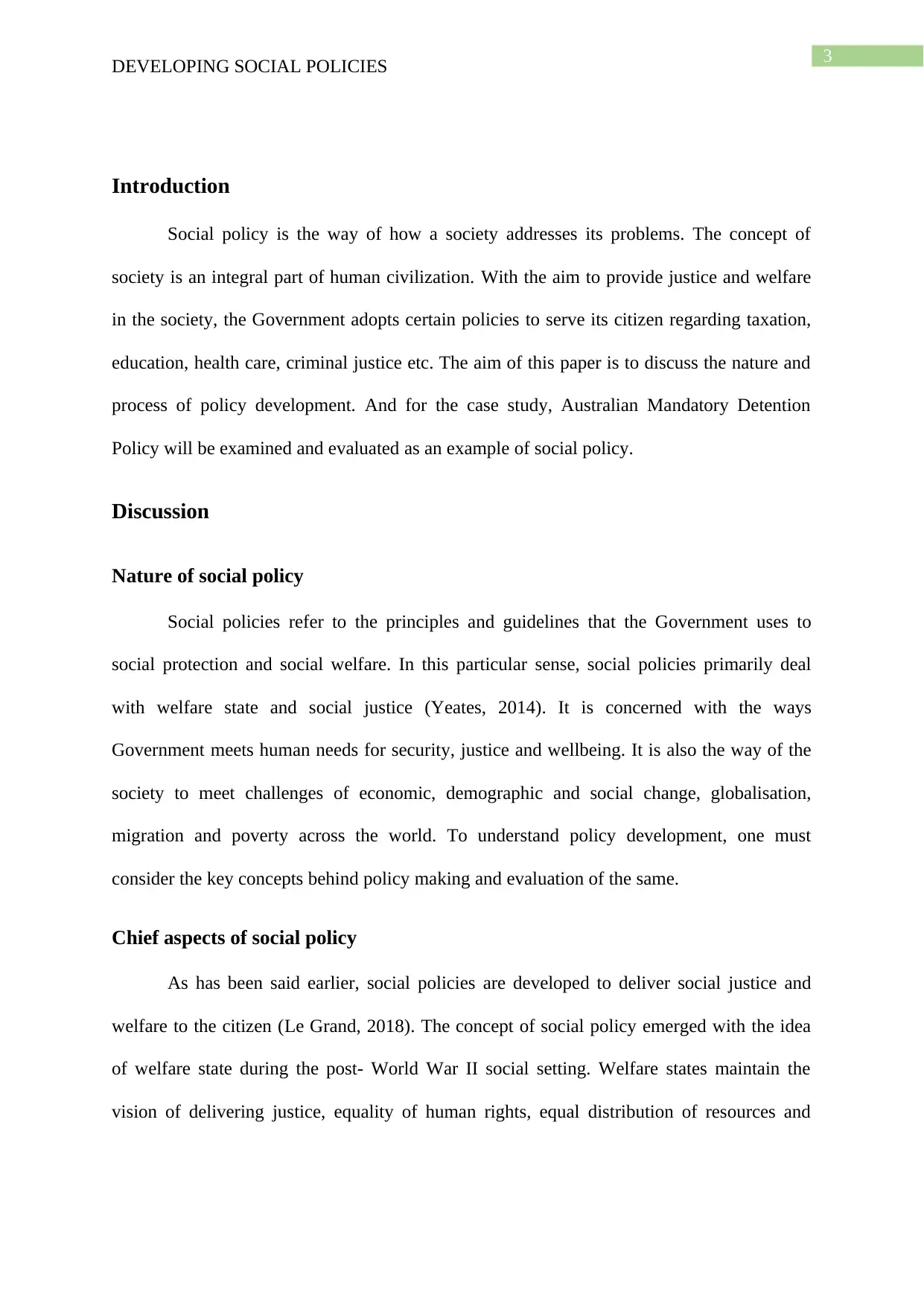
3
DEVELOPING SOCIAL POLICIES
Introduction
Social policy is the way of how a society addresses its problems. The concept of
society is an integral part of human civilization. With the aim to provide justice and welfare
in the society, the Government adopts certain policies to serve its citizen regarding taxation,
education, health care, criminal justice etc. The aim of this paper is to discuss the nature and
process of policy development. And for the case study, Australian Mandatory Detention
Policy will be examined and evaluated as an example of social policy.
Discussion
Nature of social policy
Social policies refer to the principles and guidelines that the Government uses to
social protection and social welfare. In this particular sense, social policies primarily deal
with welfare state and social justice (Yeates, 2014). It is concerned with the ways
Government meets human needs for security, justice and wellbeing. It is also the way of the
society to meet challenges of economic, demographic and social change, globalisation,
migration and poverty across the world. To understand policy development, one must
consider the key concepts behind policy making and evaluation of the same.
Chief aspects of social policy
As has been said earlier, social policies are developed to deliver social justice and
welfare to the citizen (Le Grand, 2018). The concept of social policy emerged with the idea
of welfare state during the post- World War II social setting. Welfare states maintain the
vision of delivering justice, equality of human rights, equal distribution of resources and
DEVELOPING SOCIAL POLICIES
Introduction
Social policy is the way of how a society addresses its problems. The concept of
society is an integral part of human civilization. With the aim to provide justice and welfare
in the society, the Government adopts certain policies to serve its citizen regarding taxation,
education, health care, criminal justice etc. The aim of this paper is to discuss the nature and
process of policy development. And for the case study, Australian Mandatory Detention
Policy will be examined and evaluated as an example of social policy.
Discussion
Nature of social policy
Social policies refer to the principles and guidelines that the Government uses to
social protection and social welfare. In this particular sense, social policies primarily deal
with welfare state and social justice (Yeates, 2014). It is concerned with the ways
Government meets human needs for security, justice and wellbeing. It is also the way of the
society to meet challenges of economic, demographic and social change, globalisation,
migration and poverty across the world. To understand policy development, one must
consider the key concepts behind policy making and evaluation of the same.
Chief aspects of social policy
As has been said earlier, social policies are developed to deliver social justice and
welfare to the citizen (Le Grand, 2018). The concept of social policy emerged with the idea
of welfare state during the post- World War II social setting. Welfare states maintain the
vision of delivering justice, equality of human rights, equal distribution of resources and
Paraphrase This Document
Need a fresh take? Get an instant paraphrase of this document with our AI Paraphraser
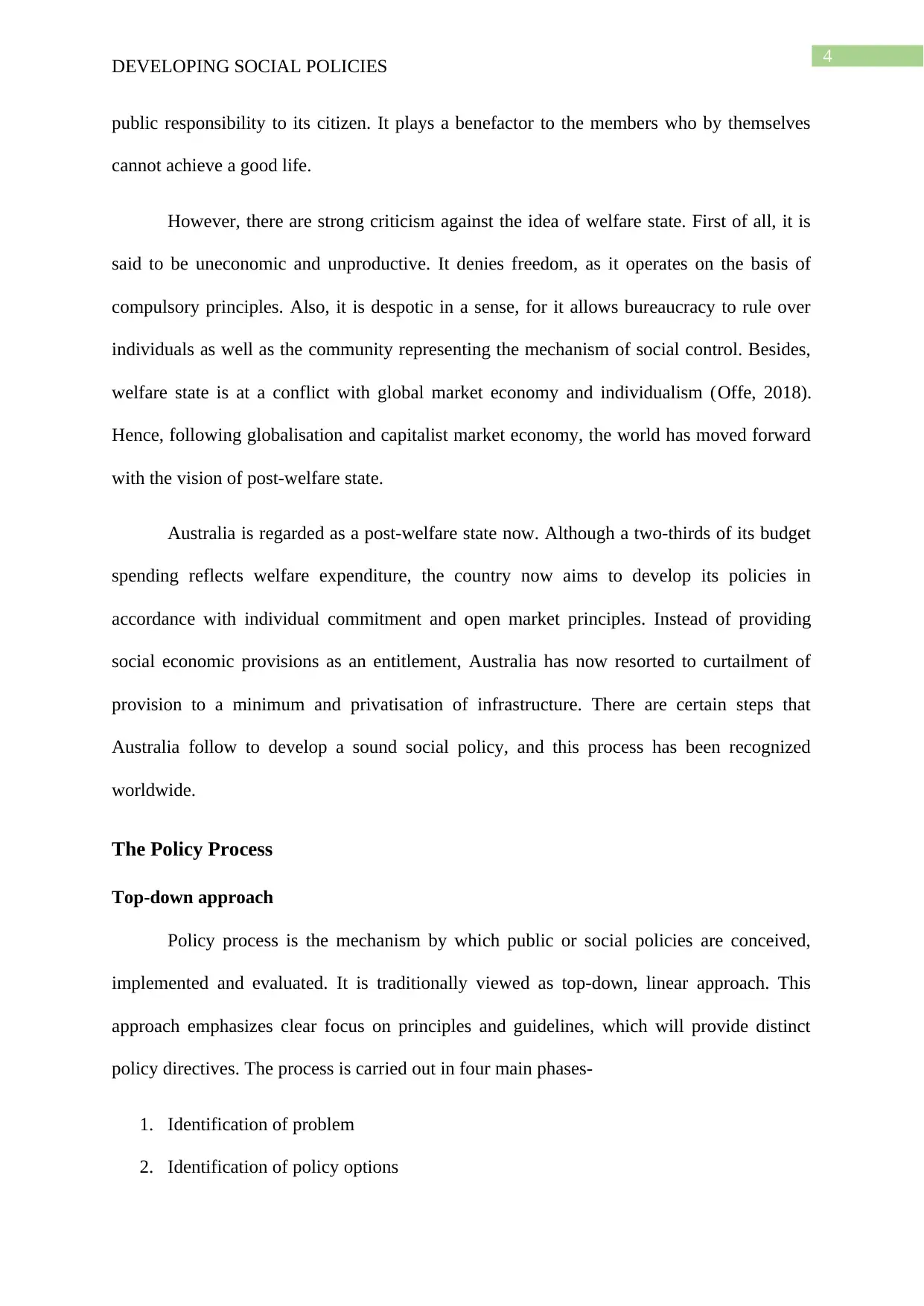
4
DEVELOPING SOCIAL POLICIES
public responsibility to its citizen. It plays a benefactor to the members who by themselves
cannot achieve a good life.
However, there are strong criticism against the idea of welfare state. First of all, it is
said to be uneconomic and unproductive. It denies freedom, as it operates on the basis of
compulsory principles. Also, it is despotic in a sense, for it allows bureaucracy to rule over
individuals as well as the community representing the mechanism of social control. Besides,
welfare state is at a conflict with global market economy and individualism (Offe, 2018).
Hence, following globalisation and capitalist market economy, the world has moved forward
with the vision of post-welfare state.
Australia is regarded as a post-welfare state now. Although a two-thirds of its budget
spending reflects welfare expenditure, the country now aims to develop its policies in
accordance with individual commitment and open market principles. Instead of providing
social economic provisions as an entitlement, Australia has now resorted to curtailment of
provision to a minimum and privatisation of infrastructure. There are certain steps that
Australia follow to develop a sound social policy, and this process has been recognized
worldwide.
The Policy Process
Top-down approach
Policy process is the mechanism by which public or social policies are conceived,
implemented and evaluated. It is traditionally viewed as top-down, linear approach. This
approach emphasizes clear focus on principles and guidelines, which will provide distinct
policy directives. The process is carried out in four main phases-
1. Identification of problem
2. Identification of policy options
DEVELOPING SOCIAL POLICIES
public responsibility to its citizen. It plays a benefactor to the members who by themselves
cannot achieve a good life.
However, there are strong criticism against the idea of welfare state. First of all, it is
said to be uneconomic and unproductive. It denies freedom, as it operates on the basis of
compulsory principles. Also, it is despotic in a sense, for it allows bureaucracy to rule over
individuals as well as the community representing the mechanism of social control. Besides,
welfare state is at a conflict with global market economy and individualism (Offe, 2018).
Hence, following globalisation and capitalist market economy, the world has moved forward
with the vision of post-welfare state.
Australia is regarded as a post-welfare state now. Although a two-thirds of its budget
spending reflects welfare expenditure, the country now aims to develop its policies in
accordance with individual commitment and open market principles. Instead of providing
social economic provisions as an entitlement, Australia has now resorted to curtailment of
provision to a minimum and privatisation of infrastructure. There are certain steps that
Australia follow to develop a sound social policy, and this process has been recognized
worldwide.
The Policy Process
Top-down approach
Policy process is the mechanism by which public or social policies are conceived,
implemented and evaluated. It is traditionally viewed as top-down, linear approach. This
approach emphasizes clear focus on principles and guidelines, which will provide distinct
policy directives. The process is carried out in four main phases-
1. Identification of problem
2. Identification of policy options
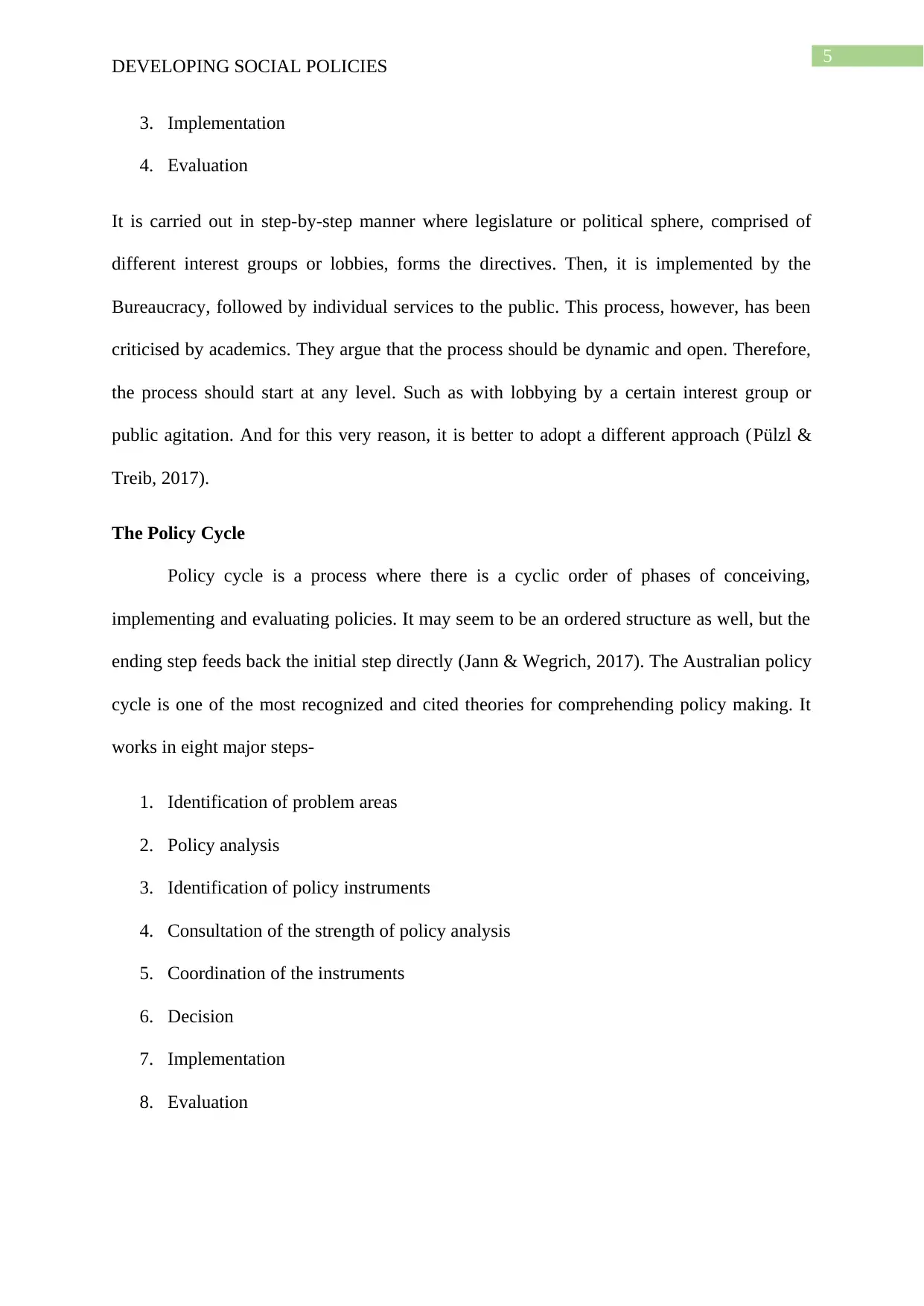
5
DEVELOPING SOCIAL POLICIES
3. Implementation
4. Evaluation
It is carried out in step-by-step manner where legislature or political sphere, comprised of
different interest groups or lobbies, forms the directives. Then, it is implemented by the
Bureaucracy, followed by individual services to the public. This process, however, has been
criticised by academics. They argue that the process should be dynamic and open. Therefore,
the process should start at any level. Such as with lobbying by a certain interest group or
public agitation. And for this very reason, it is better to adopt a different approach (Pülzl &
Treib, 2017).
The Policy Cycle
Policy cycle is a process where there is a cyclic order of phases of conceiving,
implementing and evaluating policies. It may seem to be an ordered structure as well, but the
ending step feeds back the initial step directly (Jann & Wegrich, 2017). The Australian policy
cycle is one of the most recognized and cited theories for comprehending policy making. It
works in eight major steps-
1. Identification of problem areas
2. Policy analysis
3. Identification of policy instruments
4. Consultation of the strength of policy analysis
5. Coordination of the instruments
6. Decision
7. Implementation
8. Evaluation
DEVELOPING SOCIAL POLICIES
3. Implementation
4. Evaluation
It is carried out in step-by-step manner where legislature or political sphere, comprised of
different interest groups or lobbies, forms the directives. Then, it is implemented by the
Bureaucracy, followed by individual services to the public. This process, however, has been
criticised by academics. They argue that the process should be dynamic and open. Therefore,
the process should start at any level. Such as with lobbying by a certain interest group or
public agitation. And for this very reason, it is better to adopt a different approach (Pülzl &
Treib, 2017).
The Policy Cycle
Policy cycle is a process where there is a cyclic order of phases of conceiving,
implementing and evaluating policies. It may seem to be an ordered structure as well, but the
ending step feeds back the initial step directly (Jann & Wegrich, 2017). The Australian policy
cycle is one of the most recognized and cited theories for comprehending policy making. It
works in eight major steps-
1. Identification of problem areas
2. Policy analysis
3. Identification of policy instruments
4. Consultation of the strength of policy analysis
5. Coordination of the instruments
6. Decision
7. Implementation
8. Evaluation
⊘ This is a preview!⊘
Do you want full access?
Subscribe today to unlock all pages.

Trusted by 1+ million students worldwide
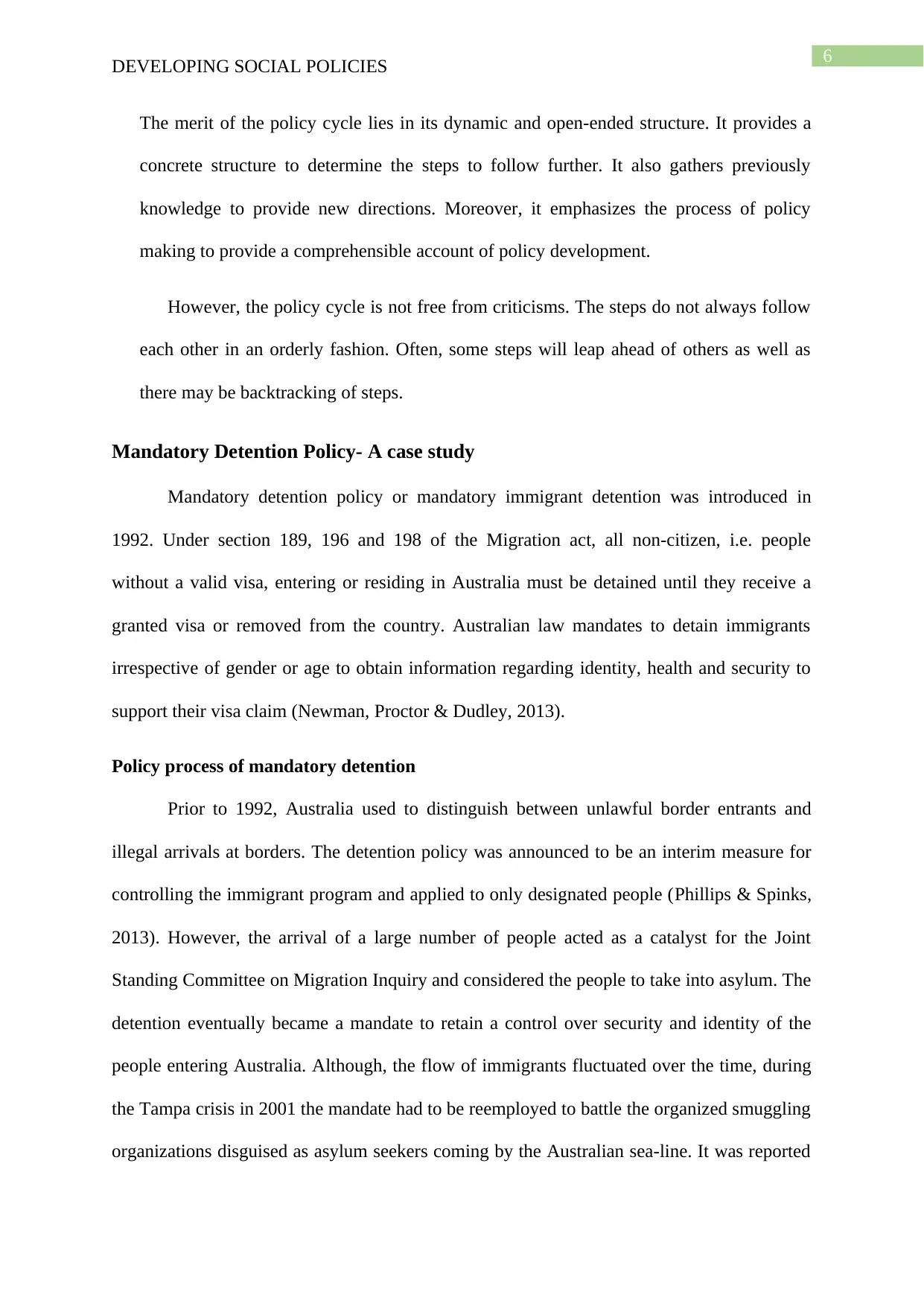
6
DEVELOPING SOCIAL POLICIES
The merit of the policy cycle lies in its dynamic and open-ended structure. It provides a
concrete structure to determine the steps to follow further. It also gathers previously
knowledge to provide new directions. Moreover, it emphasizes the process of policy
making to provide a comprehensible account of policy development.
However, the policy cycle is not free from criticisms. The steps do not always follow
each other in an orderly fashion. Often, some steps will leap ahead of others as well as
there may be backtracking of steps.
Mandatory Detention Policy- A case study
Mandatory detention policy or mandatory immigrant detention was introduced in
1992. Under section 189, 196 and 198 of the Migration act, all non-citizen, i.e. people
without a valid visa, entering or residing in Australia must be detained until they receive a
granted visa or removed from the country. Australian law mandates to detain immigrants
irrespective of gender or age to obtain information regarding identity, health and security to
support their visa claim (Newman, Proctor & Dudley, 2013).
Policy process of mandatory detention
Prior to 1992, Australia used to distinguish between unlawful border entrants and
illegal arrivals at borders. The detention policy was announced to be an interim measure for
controlling the immigrant program and applied to only designated people (Phillips & Spinks,
2013). However, the arrival of a large number of people acted as a catalyst for the Joint
Standing Committee on Migration Inquiry and considered the people to take into asylum. The
detention eventually became a mandate to retain a control over security and identity of the
people entering Australia. Although, the flow of immigrants fluctuated over the time, during
the Tampa crisis in 2001 the mandate had to be reemployed to battle the organized smuggling
organizations disguised as asylum seekers coming by the Australian sea-line. It was reported
DEVELOPING SOCIAL POLICIES
The merit of the policy cycle lies in its dynamic and open-ended structure. It provides a
concrete structure to determine the steps to follow further. It also gathers previously
knowledge to provide new directions. Moreover, it emphasizes the process of policy
making to provide a comprehensible account of policy development.
However, the policy cycle is not free from criticisms. The steps do not always follow
each other in an orderly fashion. Often, some steps will leap ahead of others as well as
there may be backtracking of steps.
Mandatory Detention Policy- A case study
Mandatory detention policy or mandatory immigrant detention was introduced in
1992. Under section 189, 196 and 198 of the Migration act, all non-citizen, i.e. people
without a valid visa, entering or residing in Australia must be detained until they receive a
granted visa or removed from the country. Australian law mandates to detain immigrants
irrespective of gender or age to obtain information regarding identity, health and security to
support their visa claim (Newman, Proctor & Dudley, 2013).
Policy process of mandatory detention
Prior to 1992, Australia used to distinguish between unlawful border entrants and
illegal arrivals at borders. The detention policy was announced to be an interim measure for
controlling the immigrant program and applied to only designated people (Phillips & Spinks,
2013). However, the arrival of a large number of people acted as a catalyst for the Joint
Standing Committee on Migration Inquiry and considered the people to take into asylum. The
detention eventually became a mandate to retain a control over security and identity of the
people entering Australia. Although, the flow of immigrants fluctuated over the time, during
the Tampa crisis in 2001 the mandate had to be reemployed to battle the organized smuggling
organizations disguised as asylum seekers coming by the Australian sea-line. It was reported
Paraphrase This Document
Need a fresh take? Get an instant paraphrase of this document with our AI Paraphraser
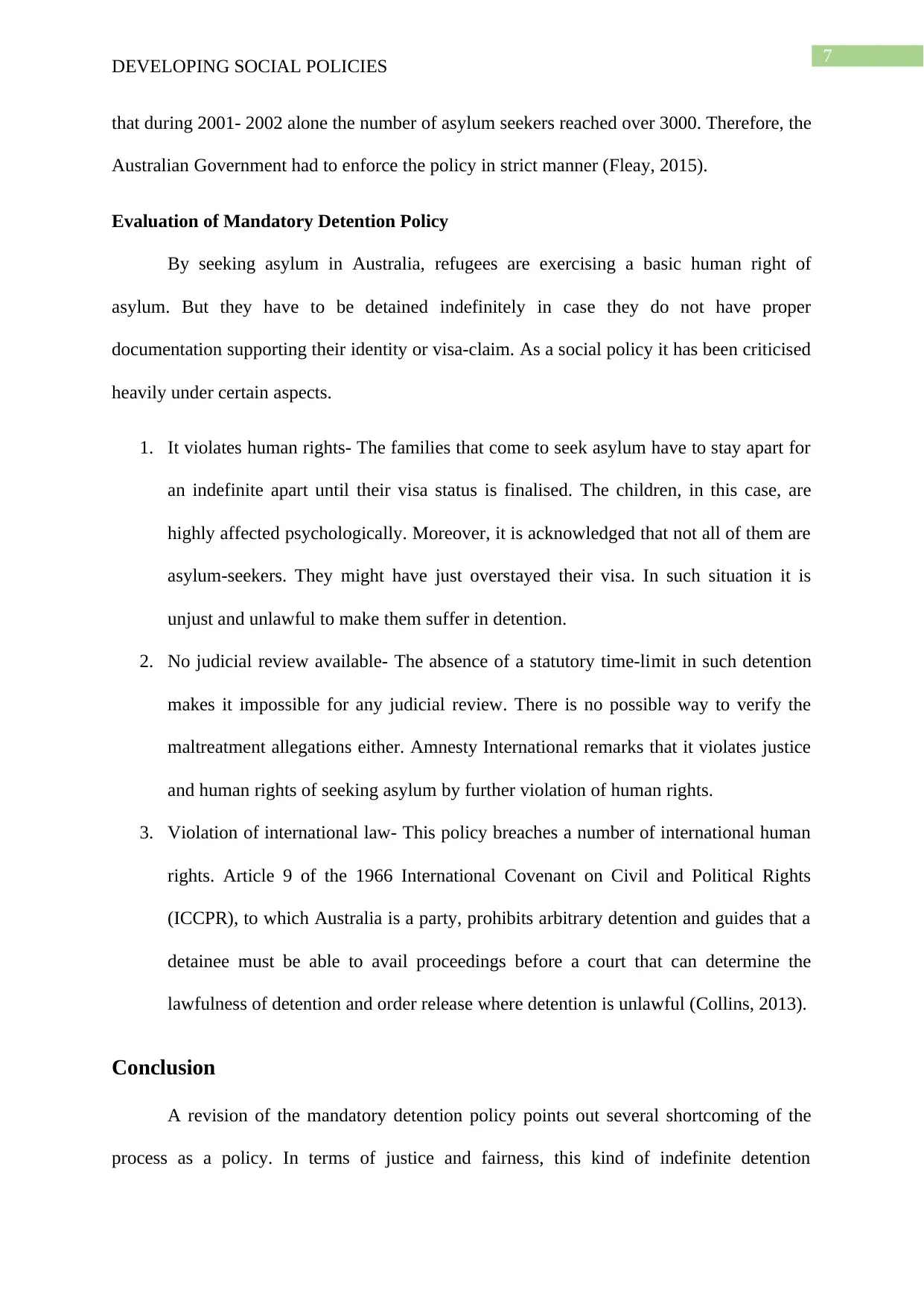
7
DEVELOPING SOCIAL POLICIES
that during 2001- 2002 alone the number of asylum seekers reached over 3000. Therefore, the
Australian Government had to enforce the policy in strict manner (Fleay, 2015).
Evaluation of Mandatory Detention Policy
By seeking asylum in Australia, refugees are exercising a basic human right of
asylum. But they have to be detained indefinitely in case they do not have proper
documentation supporting their identity or visa-claim. As a social policy it has been criticised
heavily under certain aspects.
1. It violates human rights- The families that come to seek asylum have to stay apart for
an indefinite apart until their visa status is finalised. The children, in this case, are
highly affected psychologically. Moreover, it is acknowledged that not all of them are
asylum-seekers. They might have just overstayed their visa. In such situation it is
unjust and unlawful to make them suffer in detention.
2. No judicial review available- The absence of a statutory time-limit in such detention
makes it impossible for any judicial review. There is no possible way to verify the
maltreatment allegations either. Amnesty International remarks that it violates justice
and human rights of seeking asylum by further violation of human rights.
3. Violation of international law- This policy breaches a number of international human
rights. Article 9 of the 1966 International Covenant on Civil and Political Rights
(ICCPR), to which Australia is a party, prohibits arbitrary detention and guides that a
detainee must be able to avail proceedings before a court that can determine the
lawfulness of detention and order release where detention is unlawful (Collins, 2013).
Conclusion
A revision of the mandatory detention policy points out several shortcoming of the
process as a policy. In terms of justice and fairness, this kind of indefinite detention
DEVELOPING SOCIAL POLICIES
that during 2001- 2002 alone the number of asylum seekers reached over 3000. Therefore, the
Australian Government had to enforce the policy in strict manner (Fleay, 2015).
Evaluation of Mandatory Detention Policy
By seeking asylum in Australia, refugees are exercising a basic human right of
asylum. But they have to be detained indefinitely in case they do not have proper
documentation supporting their identity or visa-claim. As a social policy it has been criticised
heavily under certain aspects.
1. It violates human rights- The families that come to seek asylum have to stay apart for
an indefinite apart until their visa status is finalised. The children, in this case, are
highly affected psychologically. Moreover, it is acknowledged that not all of them are
asylum-seekers. They might have just overstayed their visa. In such situation it is
unjust and unlawful to make them suffer in detention.
2. No judicial review available- The absence of a statutory time-limit in such detention
makes it impossible for any judicial review. There is no possible way to verify the
maltreatment allegations either. Amnesty International remarks that it violates justice
and human rights of seeking asylum by further violation of human rights.
3. Violation of international law- This policy breaches a number of international human
rights. Article 9 of the 1966 International Covenant on Civil and Political Rights
(ICCPR), to which Australia is a party, prohibits arbitrary detention and guides that a
detainee must be able to avail proceedings before a court that can determine the
lawfulness of detention and order release where detention is unlawful (Collins, 2013).
Conclusion
A revision of the mandatory detention policy points out several shortcoming of the
process as a policy. In terms of justice and fairness, this kind of indefinite detention
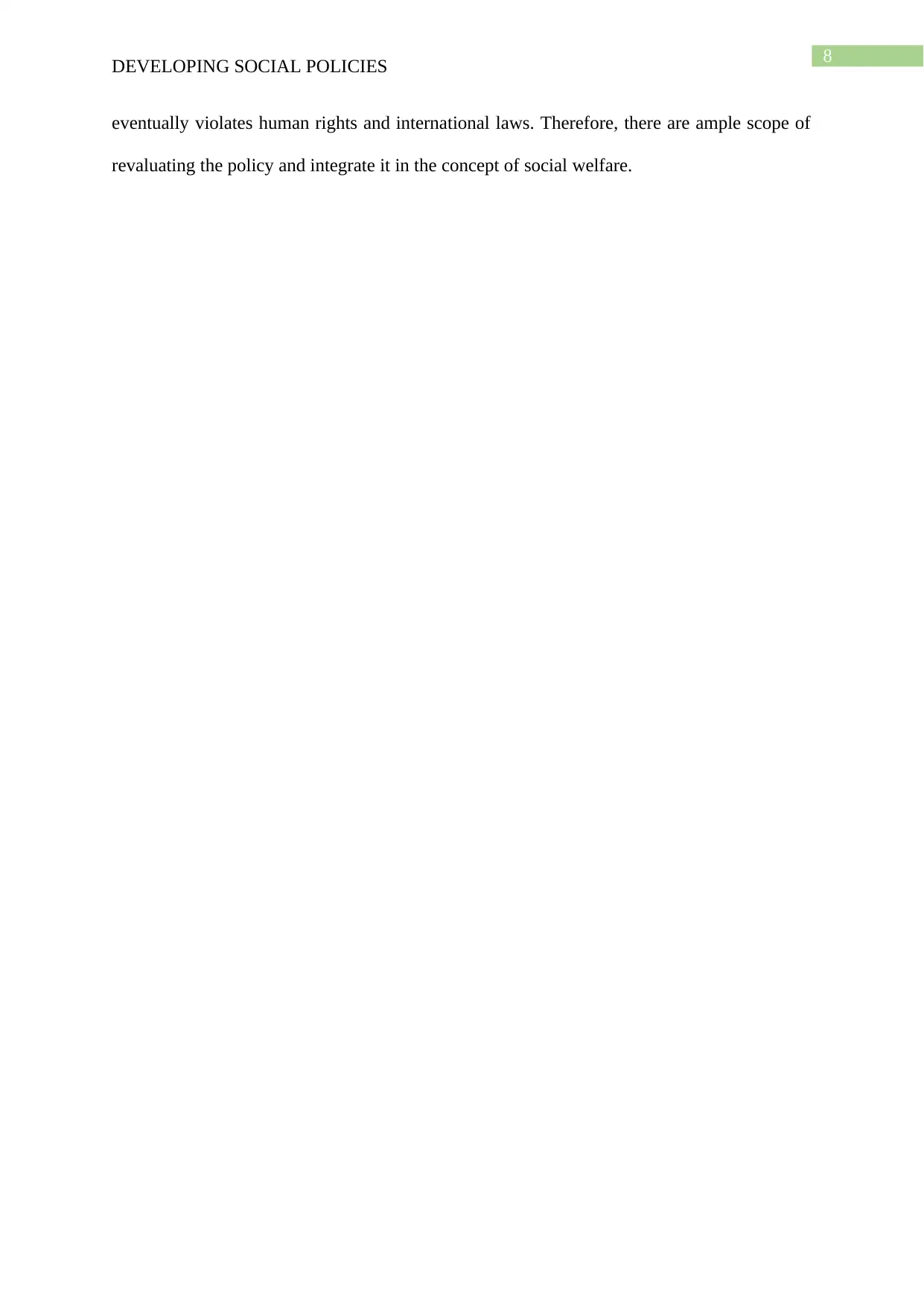
8
DEVELOPING SOCIAL POLICIES
eventually violates human rights and international laws. Therefore, there are ample scope of
revaluating the policy and integrate it in the concept of social welfare.
DEVELOPING SOCIAL POLICIES
eventually violates human rights and international laws. Therefore, there are ample scope of
revaluating the policy and integrate it in the concept of social welfare.
⊘ This is a preview!⊘
Do you want full access?
Subscribe today to unlock all pages.

Trusted by 1+ million students worldwide
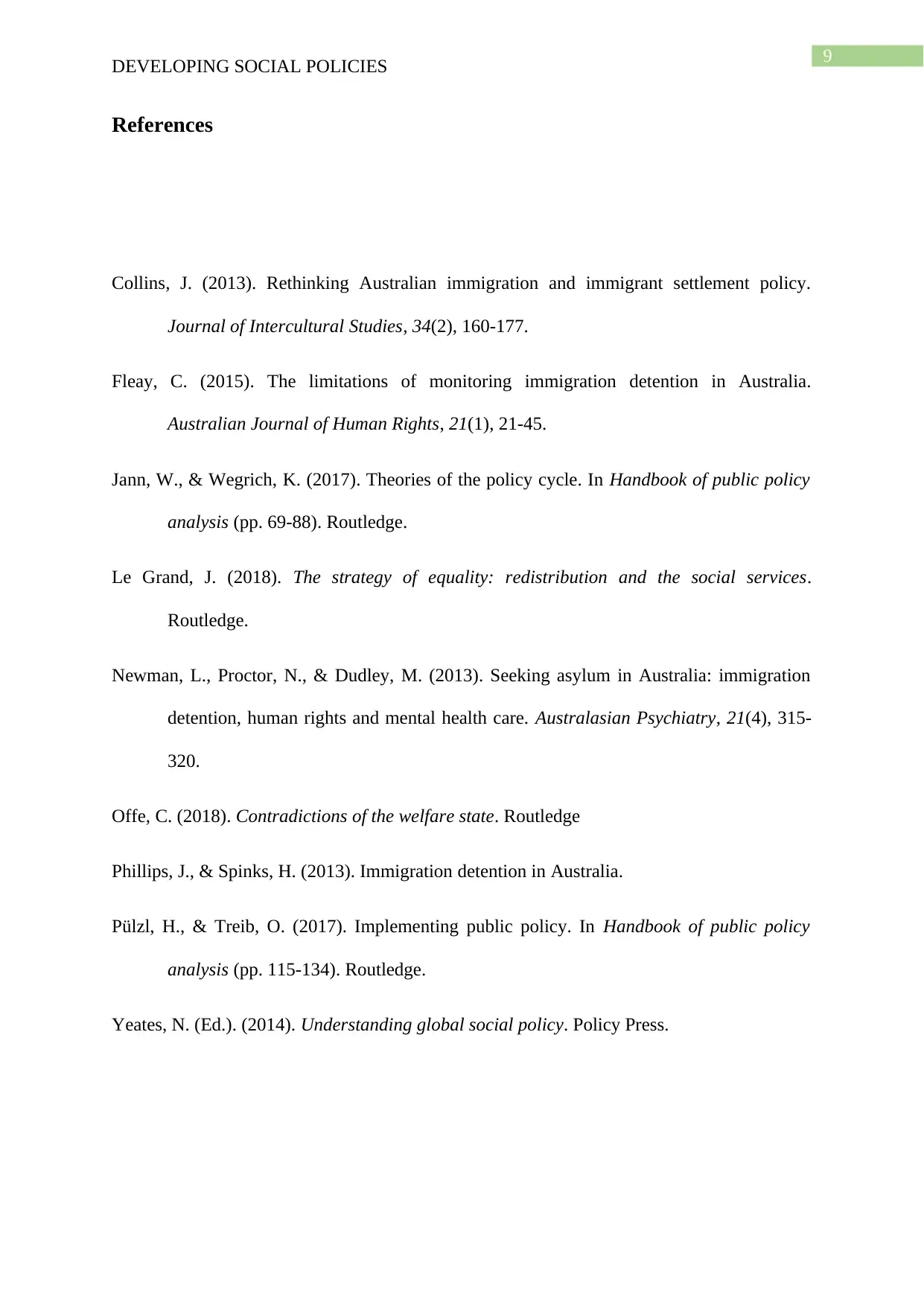
9
DEVELOPING SOCIAL POLICIES
References
Collins, J. (2013). Rethinking Australian immigration and immigrant settlement policy.
Journal of Intercultural Studies, 34(2), 160-177.
Fleay, C. (2015). The limitations of monitoring immigration detention in Australia.
Australian Journal of Human Rights, 21(1), 21-45.
Jann, W., & Wegrich, K. (2017). Theories of the policy cycle. In Handbook of public policy
analysis (pp. 69-88). Routledge.
Le Grand, J. (2018). The strategy of equality: redistribution and the social services.
Routledge.
Newman, L., Proctor, N., & Dudley, M. (2013). Seeking asylum in Australia: immigration
detention, human rights and mental health care. Australasian Psychiatry, 21(4), 315-
320.
Offe, C. (2018). Contradictions of the welfare state. Routledge
Phillips, J., & Spinks, H. (2013). Immigration detention in Australia.
Pülzl, H., & Treib, O. (2017). Implementing public policy. In Handbook of public policy
analysis (pp. 115-134). Routledge.
Yeates, N. (Ed.). (2014). Understanding global social policy. Policy Press.
DEVELOPING SOCIAL POLICIES
References
Collins, J. (2013). Rethinking Australian immigration and immigrant settlement policy.
Journal of Intercultural Studies, 34(2), 160-177.
Fleay, C. (2015). The limitations of monitoring immigration detention in Australia.
Australian Journal of Human Rights, 21(1), 21-45.
Jann, W., & Wegrich, K. (2017). Theories of the policy cycle. In Handbook of public policy
analysis (pp. 69-88). Routledge.
Le Grand, J. (2018). The strategy of equality: redistribution and the social services.
Routledge.
Newman, L., Proctor, N., & Dudley, M. (2013). Seeking asylum in Australia: immigration
detention, human rights and mental health care. Australasian Psychiatry, 21(4), 315-
320.
Offe, C. (2018). Contradictions of the welfare state. Routledge
Phillips, J., & Spinks, H. (2013). Immigration detention in Australia.
Pülzl, H., & Treib, O. (2017). Implementing public policy. In Handbook of public policy
analysis (pp. 115-134). Routledge.
Yeates, N. (Ed.). (2014). Understanding global social policy. Policy Press.
1 out of 10
Related Documents
Your All-in-One AI-Powered Toolkit for Academic Success.
+13062052269
info@desklib.com
Available 24*7 on WhatsApp / Email
![[object Object]](/_next/static/media/star-bottom.7253800d.svg)
Unlock your academic potential
Copyright © 2020–2025 A2Z Services. All Rights Reserved. Developed and managed by ZUCOL.




